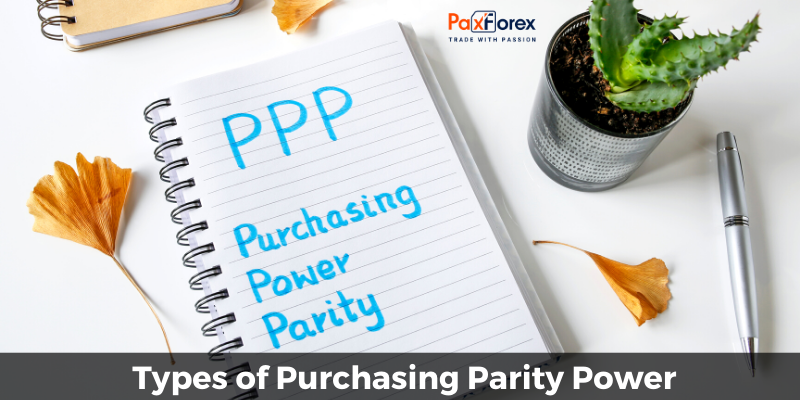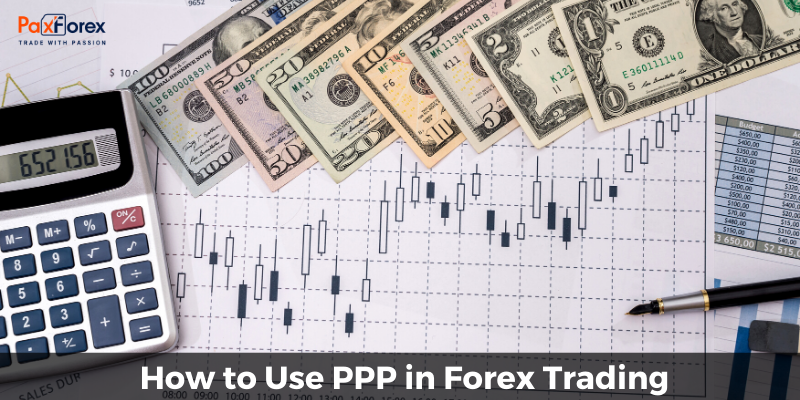
How does the price for a cup of coffee in two different countries affect the Forex market? One of the ways to answer this is by exploring the concept of a basket of goods, a commonly used microeconomics metric also known as the purchasing power of parity. Today we will discover everything there is to know about trading currency based on the PPP factor.
What is the Purchasing Power of Parity
Purchase parity power was originally designed as an attempt to find a unified measuring unit to compare currency values across the globe. The initial concept was focused around the idea that a collection of similar retail items should cost the same amount of money everywhere in the world. This way, essentially, if a person from London went shopping with the same grocery list as someone in Tokyo, they would end up spending an equal sum equivalent in their local currency.
However, this theory didn’t really live up to the expectations. Mostly because the amount of data that had to be considered was overwhelmingly difficult to organize. To simplify the process, the United Nations along with the University of Pennsylvania established the International Comparison Program (ICP). ICP’s main objective is to build a unified power purchasing parity portfolio by surveying the costs of hundreds of various services and goods.
Once every three years, the report is released by the World Bank, in which the growth and productivity of all countries are evaluated based on their purchasing parity power. The PPP metrics are then utilized by the IMF (International Monetary Fund) and the OECD (Organization for Economic Cooperation and Development) to build forecasts and recommend economic policies. The policy recommendations sometimes have a short term, but powerful effect on the currency exchange market, which makes them an important factor to consider during analysis.
Since the concept of parity purchasing power is based on the law of one price, the two often get confused. Let’s take a few moments defining the law of one price, to ensure there is no longer any uncertainty.
The Law of One Price

A concept known as the law of one price dictates that a particular item sold in one country should cost the equivalent amount in local currency elsewhere in the world. This way, if we buy a pound of apples in New York for $2.50 and the USD/GBP rate is 0.7844 (or roughly 0.78), we should expect a pound of apples in London to cost £1.96.
However, if the actual price for a pound of apples is either higher or lower, it creates a set of arbitrage opportunities. For instance, if the price is lower in the US, it would make sense to purchase over there in bulk and sell in the UK in order to make a profit. Such opportunities get exhausted quickly, as more and more entrepreneurs pick up on a profitable idea. Eventually, this leads the prices to even out, which points out to the law of one price in action.
Now, you might think that the international trade of apples has very little to do with trading currencies on Forex. But in fact, there is an entire way of analyzing the market based on similar principles. It is called the fundamental analysis.
Why Does the Purchase Parity Power Matter
How does a trader make decisions? You probably already know that there is no single answer. Some approach the trading process as if it was a lottery and simply guess their way through. Needless to say, this quickly results in miserable failure. Forex, just like any other market, is a complex mechanism that has to be treated with respect and consideration.
So, in order to get a better understanding of the overall complexity, traders adopted two main approaches: technical and fundamental. The technical analysis considers purely numerical factors: the price, the date, the level, the difference and so on. By studying the current chart and comparing it with similar charts from the past, a trader can forecast several ways for the situation to unravel. Then, based on this prediction, the trading strategy is either picked or developed to benefit from the situation.
Now, the fundamental analysis is way more abstract. It involves studying and considering various tendencies of economy, politics and sociology. For example, the turnout of an election can have a very noticeable effect on the way trading decisions are made, based on the expectations of the majority. This way, if a certain party in power has a radical view on trading policies, it will ultimately reflect on their international relations, trading and, of course, the domestic currency’s value.
The task of any trader who considers fundamental factors is to narrow down their perspective. It is impossible to keep a hand on the pulse of absolutely every government, company or organization in the world. Plus, not every government, company or organization has the same significance of influence on Forex.
When you pick which factors to include in your own fundamental analysis, start by picking one or two currency pairs to analyze. Any more than that and your research might become convoluted, self-contradicting and confusing. Additionally, the currencies you analyze should be known to change under the pressure of fundamental factors. For example, while the US dollar is incredibly driven by politics, the Australian dollar fluctuates in accordance with seasonable exports of goods.
Once you have your eyes set on the particular pair, gather all the information you might possibly need. This will include the list of institutions and companies that have the most effect on the selected currency, the times when it is traded the most and the geography of the traders who are involved in the process. You can use this guide of foreign currencies to get a general understanding.
From what we’ve covered so far, you can conclude that PPP is sort of a child of both worlds. Because while the parity purchasing power is expressed as a coefficient, which makes it a piece of technical data, it is a result of complex procedures, both external and internal, in any specific government. Additionally, the PPP measures are constantly used by major currency value dictating establishments, such as the World Bank, the United Nations, International Monetary Fund and the European Union. Understanding this can become a great asset further down the road when you practice trading with purchasing power parity.
Types of Purchasing Parity Power

So far we know that purchase parity power is an economic theory, which can be reduced to this: if a can of coke costs the same in New York and Berlin, we should essentially be able to exchange one can for another with no value difference. And we also know that due to a variety of factors, such as employment rates, for example, this isn’t really a working concept.
However, the math behind the power purchasing parity is incredibly useful to a set of trading and policy establishing institutions, which makes it a solid decision-making tool for Forex traders. Before we get into the details of purchasing parity power trading strategies, let’s first differentiate two types of PPP, which can be used both separately and as a combo.
Absolute Purchasing Power Parity
Absolute parity purchasing power (APPP) is basically the original PPP theory about two baskets of goods from different countries costing the same amount. More often than not, this concept is tied with exchanging any specific currency for USD. Coming back to the example of purchasing apples, if we bought a pound for $2.50 in Los Angeles, theoretically the price will remain the equivalent of $2.50 in Sydney.
And if that’s not the case, according to the theory the continuous arbitrage will eventually lead to two currency values balancing in the way that the pound of apples costs $2.50 everywhere. The problem with this approach is the disregard of several heavy factors like inflation, consumer spending behavior, transportation costs and so on, which means that the true power of currency is underrepresented.
Relative Purchasing Power Parity
Relative purchasing power parity (RPPP) fixes this problem. By still considering that two baskets of goods from different countries should cost the same amount, RPPP suggests that inflation plays a big role in the formation of currency exchange rates. For example, if the annual inflation rate is 5%, it means the same sum of money will be capable of buying 5% less each new year.
So, the relative parity purchasing power takes this into consideration and simply includes inflation into the calculation process. The formula for APPP, which is dividing the cost of good X in currency A by the cost of good X in currency B, serves as a basis. The mentioned division gives us the spot exchange rate, described by the purchase parity power.
And since the relative power purchasing parity is essentially the estimation of how the spot rate will change under influence of inflation, it can be calculated by dividing inflation A plus one by inflation B plus one, squared by the necessary amount of periods and then multiplied by the spot exchange rate calculated through the APPP formula.
Big Mac Index
Economists have worked out a variety of ways to measure purchasing parity power, from highly professional OECD’s comparative price index, to something slightly more fun, for example, the Big Mac index.
Big Mac index is one of the most recognized ways to measure PPP and it is based on calculating how much currency units you will need to purchase the famous fast-food sandwich. This theory originated from McDonald’s unprecedented global reach of over 34 thousand locations in 118 countries. And since the burger is supposed to be the same in every country, by knowing its price in every country we can successfully calculate the exchange rates.
It is worth pointing out that due to differences in the cost of ingredients, labor practices and so on, the price of the burger is still not an ideal representation of parity purchasing power. Plus, in some countries, Big Mac is not even the measuring point for the index, despite its name. In India, a predominantly Hindu country, beef burgers are not available, thus a chicken burger serves as a substitute. However, it is still effective to a certain degree. Here is an example.
Let’s imagine that we want to compare the purchasing power of the British pound and the Canadian dollar by applying the Big Mac index. In the second quarter of 2020, the cost of the sandwich in London was 3.19 GBP and in Toronto — 4.99 CAD. The implied purchasing power of parity comes down to 1.56, however in reality the rate is actually 1.76. From which we conclude that the pound is overvalued against the Canadian dollar by 12.8%, which in the world of theory will result in the proportional decline in the GBP’s value.
PPP and GDP
Circling back to fundamental factors used in the analysis of most major currency pairs, GDP (Gross Domestic Product) is often calculated with consideration of parity purchasing power metrics. GDP is an important economics measurement, as it reflects the summed value of services and goods produced by the country in question, over a specific time period. This data ultimately serves as an indicator of economic growth and stability, which then reflects in the domestic currency’s value. Every country has to collect and report their own data, which will be later compared with data from all other countries.
Another way to approach GDP apart from using purchase parity power is a so-called nominal GDP. This method is essentially a process of translating exchange rates into gross domestic product data. There are two major issues with this technique. First, nominal GDP doesn’t account for volatility, which is a very common characteristic of most pairs on Forex. The fact that the currency fluctuates in value, no matter how dramatic, doesn’t always change the standard of living in the said country. This means that the nominal GDP doesn’t truly display the gross domestic product of the country.
The second issue is that GDP only looks at the traded goods. So, things like the cost of taking a taxi to work or getting a spa treatment. Since the non-traded goods and services play a huge role in the reflection of a healthy economy, the nominal GDP is primarily replaced by GDP by PPP, because purchase parity power is more capable of expressing the value of non-tradable services and products.
At this point, we’ve covered a decent portion of theory, but how would it help in the process of trading currencies? Next, we are going to talk about using power purchasing parity to build effective Forex strategies.
How to Use PPP in Forex Trading

The power purchasing parity is commonly used by Forex traders, as it can serve as an instrument of prediction of the upcoming direction of the price. It is worth noting that such predictions are mostly long term since factors like PPP do not tend to change drastically overnight.
While traders actively use power purchasing parity to analyze the market and determine possible entry and exit points for their trades, PPP shouldn’t be the only measuring tool involved. Any economic theory is first of all an idea that will not always play out according to the textbook. That’s why no matter how meticulously you approach fundamental analysis, it is always important to keep in check with technical indicators. Because when the theory says that the price should be going up, but the chart is strongly suggesting otherwise, it would be wise to minimize long positions, until the technical situation reverses in your favor.
The most common approach to trading Forex using power purchasing parity is to go from the rates released by OECD. The rate release happens annually at the very beginning of the year. You might ask: doesn’t this mean that the rates in the report won’t stay true for such a long period of time? And you would be right because they won’t. In order to get a clearer picture, you might want to account for inflation rates every now and then.
Once you got the numbers from the OECD report, note all information is presented with USD as the base currency. So, in case your chosen pairs don’t include the greenback, additional math will have to be done. Then we compare the PPP listed on the report with the actual exchange rate at the moment and get the real exchange rate (RER). RER ultimately serves as the baseline for the upcoming trading process: if it is more than 1 the base currency is overvalued, and when it is below 1 — undervalued.
After you sort the report data according to RER, you will be able to identify the cheapest and the most expensive currency. From there, the most intuitive approach is to short the most expensive one and then go long the cheapest. This can be basically summed up into the very essence of Forex trading, which is relative value speculation.
Advantages and Disadvantages of Purchasing Power of Parity
From what we’ve learned today, we can sum up several pros and cons of trading with power purchasing parity. The main advantage is that the concept of PPP is relatively easy to grasp, but at the same time, it serves as a base for a good number of significant fundamental measurements, such as GDP, for example.
Additionally, the math behind purchasing parity power is pretty straightforward, making the trading process faster than many other approaches. Once you have mastered incorporating PPP in your strategies, you will know what to look out for and how to use data in the most effective way.
On the other hand, we have already discussed that PPP isn’t an ideal representation of the currency value. The theoretical arbitrage, which is expected to even out currency values, hits the wall of reality, consisting of transportation costs and fees, as well as other factors.
Additionally, the concept of the identical basket of goods in two separate countries works better on paper. Mostly because it is nearly impossible to collect the goods and services that are completely interchangeable across the borders. Also, due to the fact that the amount of data that needs to be considered is incredibly large, the calculator process often becomes complex and self-contradictory. Therefore, trading with PPP has to always be as conscious as possible, with the incorporation of other analytical factors.
Purchasing Parity Power: Summary
Let’s briefly sum up today’s post, by bringing out the most consideration-worthy info on the purchasing power of parity.
PPP is a way to measure exchange rates between currencies, judging from the value differences of goods and services in each country.
According to the theory of parity purchasing power, the pound of apples should cost the same amount in equivalent currencies in New York and London.
When the actual values don’t match, the process of arbitrage should even them out. This doesn’t always work due to a number of factors, not considered in the theory.
Forex traders use purchasing parity power to forecast long-term fluctuations in selected currency pairs and build their trading strategies accordingly.
Because of some of the limitations of purchase parity power, it needs to be used in combination with other fundamental and technical factors.







